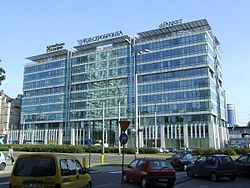Rzeczpospolita (newspaper)
| Rzeczpospolita | |
|---|---|

|
|
| description | Polish daily newspaper |
| publishing company | Presspublica Sp. Z oo |
| First edition | 1944 (discontinued in 1950) and 1982 |
| Frequency of publication | daily Monday to Saturday |
| Sold edition | 120,172 copies |
| (ZKDP March 2009, Mon. – Sat. Total) | |
| Editor-in-chief | Bogusław Chrabota |
| Web link | www.rp.pl |
| ISSN (print) | 0208-9130 |
Rzeczpospolita ( [ʐɛt͡ʂpɔsˈpɔlʲita] , " The Republic ") is the second largest reputable national daily newspaper in Poland after Gazeta Wyborcza (the fourth largest under consideration of the tabloids) with a printed circulation of approx. 200,000 copies and an estimated readership of 1.3 million. It is published by the Presspublica publishing house, which is owned by the entrepreneur Grzegorz Hajdarowicz .
The Rzeczpospolita appears Monday to Saturday in the so-called tabloid format (until October 14, 2007 as broadsheet format ) and maintains a drier and more elitist image than z. B. the more popular left-wing liberal Gazeta Wyborcza , which also has elements of the tabloid press.
The thematic and color-highlighted three-part division of the newspaper is striking: In addition to the normal news section (white), the business section appears on light green paper, and there is also a daily legal section on yellow paper. In addition to these daily sections, supplements on various topics appear once or twice a week (e.g. car and real estate market, career, television program, culture, travel). Saturdays appearing feature -Beilage plus-minus , in the well-known authors and politicians essays published on cultural, political and historical themes that reflect a wide spectrum of opinions. The Rzeczpospolita also publishes regular rankings on companies, institutions and authorities.
history
Today's Rzeczpospolita emerged from the former communist government newspaper of the same name, which first appeared in July 1944, during the Second World War . At the time, the title consciously linked to the newspaper of the same name from the right-wing conservative Christian National Party (SCN) from the interwar period in order to build a certain legitimacy in the Polish post-war public, which was consistently opposed to the new communist government. At the same time, with the founding of the Polish United Workers' Party (PVAP) in 1948, their newspaper Trybuna Ludu (“People's Tribune”) appeared. In 1950 the Rzeczpospolita was discontinued because the simultaneous existence of a party and government newspaper in the consolidated one-party state was superfluous.
During the political crisis of 1980, when the image of the party ( PVAP ) was further damaged, the idea of reviving the newspaper arose to emphasize the independence of the government. Since 1982 Rzeczpospolita appeared as an organ of the government apparatus, at the same time continued to appear the party newspaper Trybuna Ludu .
This dualism corresponded to the situation in the Soviet Union, where Pravda was also published as a party and Izvestia as a government paper; Incidentally, the development of Izvestia in Russia after the fall of the Wall is very similar to that of Rzeczpospolita in Poland.
In 1991 the Rzeczpospolita was given independence by the new democratic government. Founding editor-in-chief of the independent Rzeczpospolita was the well-known Polish journalist Dariusz Fikus from 1989 to 1996 (†) . A joint venture was established between the Polish state treasury and the French publisher Robert Hersant (1920–1996), the Presspublica publishing house, in which the newspaper has appeared since then.
In 1996 the Norwegian group Orkla Media took over the shares in the Hersant group and held 51% of Presspublica until 2006 when it sold its shares in Montgomery. At the end of January 2005, the Rzeczpospolita got into discussion after an editor ( Bronisław Wildstein ) had an inventory list of the Institute for National Remembrance ( Instytut Pamięci Narodowej , IPN) with the names of employees, candidates and victims of the Polish Stasi counterpart Służba Bezpieczeństwa (“Security Service “) Had stolen and distributed. Wildstein was released on January 31, 2005.
The political line was liberal-conservative until 2006. The government formed in autumn 2005 by the national conservative party “ Law and Justice ” (PiS) under Jarosław Kaczyński enforced the appointment of the national Catholic publicist Paweł Lisicki as the new editor-in-chief as co-owner . As a result, several prominent editors left the newspaper, they were replaced by national conservative and national Catholic authors. Since then, the editorial team has relied on confrontation, especially in reporting on Germany.
Montgomery sold its shares in 2011 to Grzegorz Hajdarowicz , who also acquired the state stake of 51 percent and thus completely took over the newspaper. He immediately replaced Lisicki with the more moderate Tomasz Wróblewski .
On October 30, 2012, the newspaper published an article by Cezary Gmyz on the front page about alleged traces of explosives on the wreck of the Polish presidential plane that crashed on April 10, 2010 near Smolensk , which, however, turned out to be incorrect. Wróblewski was then released. Bogusław Chrabota became the new editor-in- chief .
Web links
- Website (polish)
Individual evidence
- ↑ Information according to of the Polish circulation control ZKDP regarding the average sales in March 2009 in a list at Media2.pl from May 8, 2009 (in Polish)
- ↑ according to Article from the Rzeczpospolita archive of April 22, 1996 on the occasion of the death of Robert Hersant (in Polish)
- ↑ Dzieci Kaczyńskiego, in: Newsweek Polska , May 2, 2015, p. 24.
- ↑ It is very hit. The Polish media's image of Germany . In: Osteuropa , 1/2007, pp. 60–63
- ↑ Hajderowicz 100 percent. gazeta.pl, October 12, 2011.
- ↑ Wróblewski Nowym naczelnym. tvn24bis.pl, October 27, 2011.
- ↑ Bogusław Chrabota redaktorem naczelnym. rp.pl, December 20, 2012.